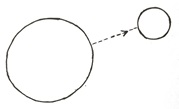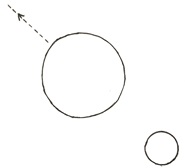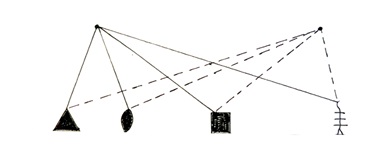Space

These three arrows all point out from the circle. Anyone standing on Earth at these points could point upwards. However, each person’s up is pointing in a rather different direction. As far as direction is concerned, up is relative to where you are. There is no consistency in regards direction with the up word. Each arrow does, however, point away from the centre of the Earth. That is consistent. There is good reason for me pointing this out. It is to give you a different way of seeing the universe and how you understand things to be.

In this illustration you are heading upwards away from the Earth down towards the moon. You will be going up and down at the same time.

In this illustration you are going up away from the Earth and up away from the moon too. Up and down is an odd inconsistent concept. There is another way to describe changes in position. We can focus our minds on changes in distances between you and other objects. No matter where the moon is, no matter if you are going up, down, left, right, forward, backwards, rolling or yawing, namely moving in one of the six degrees of freedom, distances apart change.
Whilst we refer to three axes, three planes, three dimensions, there is only one dimension of space. By extension having the thought of three dimensions brings about theories regarding a potential 4th dimension, or 5th dimension, and so on. If we have three dimensions, then logically we might have more. How can three dimensions be one dimension of space? When we talk about three dimensions we refer to width, length and height. Or forwards/backwards, up/down, left/right. These are axes, planes. The single dimension of space concept is supported by the problem of not being able to have a two-dimensional object, nor a single dimensional one.
If I handed you a box, how do you decide what is the height, what is the width and what is the length? You may refer to markings that someone else has made on it, but there is no definitive way to say which is which. A box doesn’t have a width, height and length definitively, but three distances from the sides in each plane. We talk about drawing something in two dimensions, 2D. However, a picture is never 2D for it will have a thickness. If that thickness were to be declared as infinitely thin, it is still more than zero. A sheet of paper is a 3D object else it would be invisible. It would be non-existent in reality. Anything with an axis value of zero is a non-entity. We interchange the word dimension with planes and axes too readily. There are three axes, three planes and three dimensions of an object but you cannot have a one-dimensional object nor a two-dimensional object. Three axial-dimensions is a single dimension of space. Given that one/two dimensional worlds are non-existent, the logical hypothesis of there being a 4Th or 5Th dimension fades away.
A friend of yours may claim to be 12400 miles away from you given that they reside on the other side of the planet. However, they are circa 7900 miles away. It is not just your friend that is a straight-line relative distance apart, but all things are a certain relative distance away from you.

The crude sketch above helps you grasp the idea that all objects are a set relative distance apart. When you move, the distances change. Every distance changes. When you move on Earth your distance to a crater on the moon changes. Axial movements can be translated from straight-line distances alone. When you climb a set of stairs you move fifteen step lengths (diagonally) away from the bottom. That is equivalent to nine forward and twelve up. If you have a tool to measure your straight-line distances from satellites orbiting the Earth, you can calculate where you are. As you move you can determine your change in position, change in altitude, change relative to certain things on Earth.
The top of this book is for argument’s sake, one metre from the door, one metre from the floor and a whole range of distances from everything in the room. Turn the book over and all those distances change. Each object, each atom, every item in the universe is a certain distance, a relative distance, from one another. People struggle to escape the architects view of the world. Up is up, no matter what you say. But your up is down to those on the other side of the world and sideways for those living halfway around from you. Replace up with away from the centre of the Earth and you have something consistent no matter where you are pontificating from.
We once thought that the Earth was at the centre of the universe. We later proclaimed that the Earth orbits the sun. Both notions are perfectly true. As you read this, in your spot in the universe, you are perfectly entitled to claim that you sit at the centre of it all. Everything is moving in relation to you, relative to you, changing relative distances from you.
The measure of the relative speed of light differs according to the medium it is passing through. The speed can be affected when surrounded by mass. Light shone through a tunnel beneath the earth will differ in relative speed from light shone above ground.
Magnetism and radiating forces are brought about by the arrangement of true atoms. These arrangements enable tunnelling effects and internal vibrations to manifest themselves.
Copyright © 2003-2025. Ignorance Paradox all rights reserved. First published 2003. Updated 2025